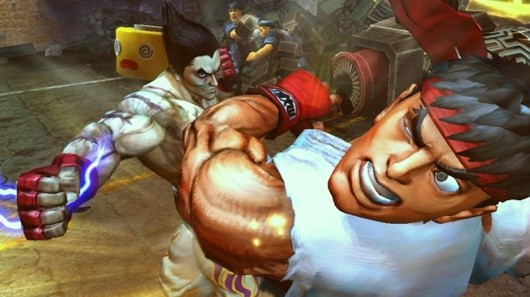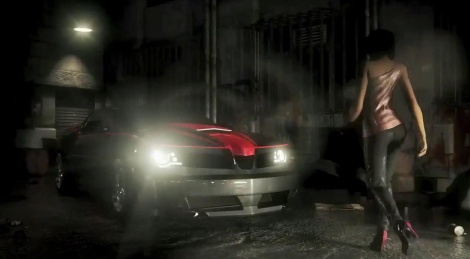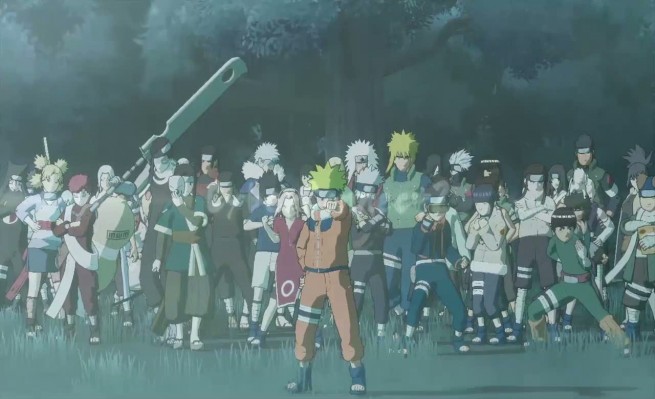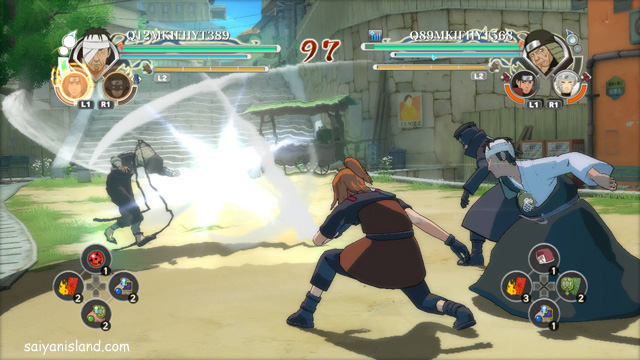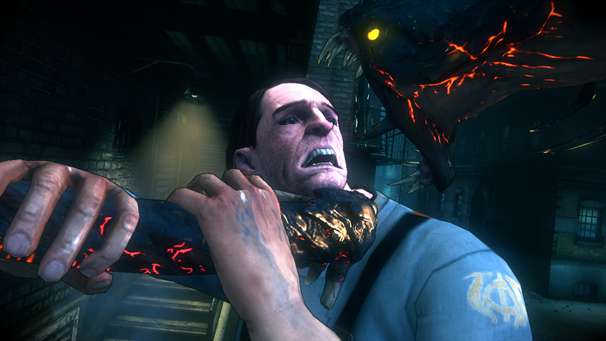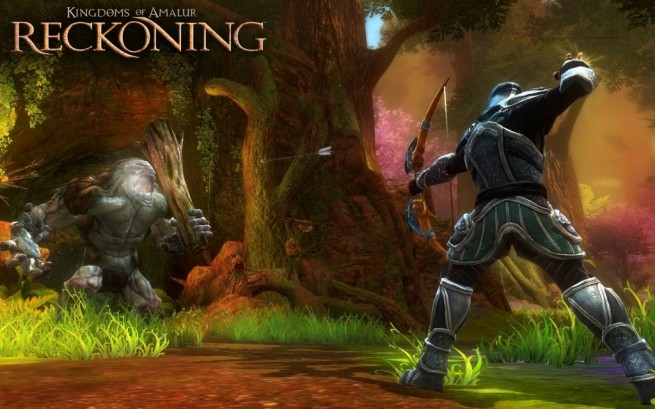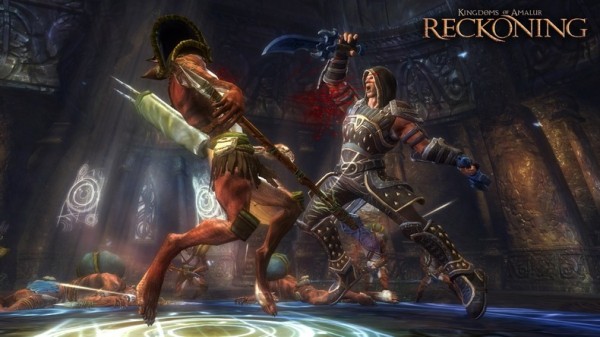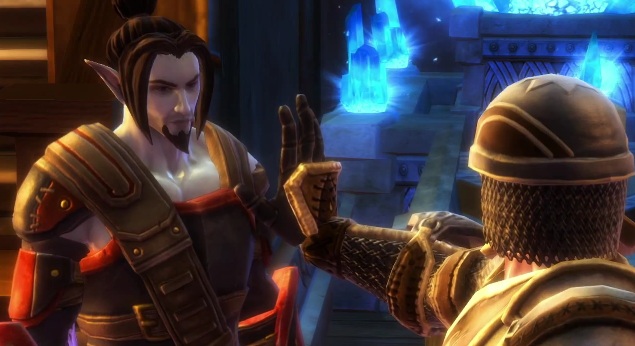BlazBlue: Continuum Shift Extend (PlayStation Vita)
BlazBlue’s beauty is more than skin deep.
Developer Arc System Works is no stranger to crafting beautiful hand-drawn 2D fighting games. Previously having worked on the Guilty Gear series, ASW has taken over a decade of experience and honed it all to manifest their magnum opus with BlazBlue: Continuum Shift Extend (an enhanced version of the second BlazBlue title).
Aside from what are hands-down the most stunning HD visuals on the Vita, Extend offers a sizable selection of varied characters to choose from: gunslingers, ninjas, robots, cats girls… there’s something for everyone. The character design is imaginative, and each fighter has a robust moveset of combos and special moves that feel truly unique, as opposed to carbon copy clones with slightly different fireball and uppercut attacks.
The main menu is bustling with 16 different options and modes: arcade, story, time attack and survival, as well as a few interesting variations and a gallery mode with tons of unlockable content. Rather than repeatedly gouging customers with old DLC, Extend smartly includes all previous premium console characters (a total of four) at no extra charge, and even gives them new story campaigns. Capcom could learn more than a few things from Arc System Works.
The two biggest issues holding Continuum Shift back are the platform on which it was released, and the thorough story elements that unfortunately tend to drag or otherwise lack imagination. The Vita was simply not designed for fighting games (despite the large number of them being released for the handheld), but this can be remedied by buying a console version of the game. The story, however, is quite exhaustive, though not always in a good way. Characters are fleshed out, but cutscenes and dialogue can go on for too long or generally be painfully cliche. Arc System Works is the leader in providing deep story in its fighting games, but the quality of writing doesn’t quite match the excellent voiceover work.
CONCLUSION
Whether you want to just button-mash with friends, auto-pilot through the story on easy mode, or compete online, BlazBlue: Continuum Shift Extend can be as shallow or deep as you want it to be. It’s not only the best-looking 2D fighter ever created, but in my opinion, it’s also one of the best and most feature-laden fighting games period — a statement I do not make lightly.
Score: 88/100
BlazBlue: Continuum Shift Extend was released on February 22, 2012 for the PlayStation Vita. A copy of the game was provided by the published for the purpose of this review.
Street Fighter X Tekken
A promising fighter depreciated by shady business tactics.
At its core, SF X Tekken has some good ideas and mostly solid gameplay. Sporting a massive roster of 38 brawlers split between the Tekken and Street Fighter franchises, there’s a lot to like. Street Fighter IV’s focus attacks have been removed, but in their place are a slew of crossover and tag-specific moves, plus a truly game-changing new charge technique that unleashes a free Super at its highest level. The Tekken characters have all been dumbed down to a Street Fighter level, losing intricate combo strings and mix-ups in favor of basic quarter-circle (“fireball”) variations. Countless signature moves have also been stripped away from the Tekken crew, so you’ll have to learn your favorite character(s) all over again.
There are also a handful of concepts that weren’t properly fleshed out or balanced. The Gem system, a throwback to the good old days of Marvel Super Heroes, feels a bit alien in the Street Fighter universe, and has all but ruled out SF X Tekken from being included in the pro-gaming circuit. Likewise, the Pandora system, where a near-death character can be sacrificed to temporarily overpower the remaining combatant, is thoroughly useless. Once activated, you have mere seconds to finish your opponent before you automatically lose. A better method would be to sacrifice a character with full health at the beginning of the round, pitting your one suped-up fighter against your opponent’s duo.
Capcom half-heartedly attempted a story to mixed results. Characters have unique interactions and cutscenes, but only if you matched them with their pre-ordained partner. These pairs are only ever from the same franchise, which is a missed opportunity. Lag and various other technical issues mar the online experience, and the highly-touted pair play feature was not included in the Xbox 360 version — a move Capcom has stumbled over its own words trying to explain and is now answering for with the Better Business Bureau.
By far the worst offense is that Capcom saw fit to disable and lock away huge chunks of on-disc content. This includes — but is not limited to — 12 characters and approximately $100 worth of costumes (two for each character, at $1 a pop). Vital features such as preset combos and character customization are unnecessarily restricted out of the box, despite everything being confirmed as on-disc. Hackers have even unlocked said content and are now rampaging online in Ranked matches with the new characters.
CONCLUSION
Capcom has crafted a video game crossover that few would have ever believed possible. Part of that disbelief will undoubtedly come from how poorly the Tekken characters’ signature style and feel were retained during the conversion, and the rest will come from the major bugs, missing features, and locked content. While there is a competent fighter to be had, the woeful way in which Capcom has blatantly stripped out significant chunks and promised features, or locked away vital content that already exists on the disc, all with the vile intent of having you pay for it again, makes this a hard game to recommend.
Since Capcom only seems to think about your wallet when releasing its games, you should too before buying into their bullshit.
Score: 60/100
Street Fighter X Tekken was released on March 6, 2012 for the Xbox 360 and PlayStation. An Xbox 360 version was provided by the publisher for the purpose of this review.
Ridge Racer: Unbounded
A Ridge Racer product in name only.
Namco has been pumping out the same Ridge Racer game for the past few years now. It more or less started in 2004 with “Ridge Racer” for the Vita, which was a compilation of content from previous titles. Many of those same tracks and vehicles were then recycled in various Ridge Racer releases for the Xbox 360, PlayStation 3, Nintendo 3DS, and most recently the PlayStation Vita.
Handing the reigns over to a fresh developer was a nice thought, and I was secretly rooting for Bugbear to overcome the faults of its previous racing titles and deliver a thoroughly kick-ass four-wheel brawler. But as the ridiculous “Unbounded” moniker suggests, this game fails on a number of levels. First and foremost are the instantly forgettable courses. They all feel and look the same (partly because you often race on the same course with a slightly different layout). The game doesn’t look bad, it just has no identity of its own.
You’re required to build up boost by drifting, drafting, or catching air. Once your bar is full you can activate a short boost effect which will allow you take out opponents or destroy certain environmental objects. The shortcut concept is good (albeit not particularly new), but its execution is poor as the “shortcuts” are rarely faster than the standard path. In fact, the key to all races is to get ahead early and then drive normally, not partaking in any of the game’s “special” mechanics. If you’re not leading by the halfway point, you might as well start over. Likewise, a single mistake or crash can often irreversibly send you to the back of the pack, regardless of how far ahead you were. The game’s erroneous physics (a common fault in Bugbear titles) compound the mediocre gameplay.
Is a terribly executed and uninteresting story worse than no story at all? That’s the question you’ll be asking yourself during Unbounded’s god-awful cutscenes. Racing games typically avoid story altogether, though the Need For Speed franchise temporarily embraced intentionally campy live-action to add some unique flavor. Unbounded opts to go a different route, where the story is just plain bad. Cringe-worthy, even.
CONCLUSION
Is the Ridge Racer franchise long overdue for a renaissance? Absolutely. Is Unbounded a step in the right direction? Absolutely not. A glossier coat of paint can’t hide Bugbear’s signature unbalanced gameplay and defective physics. At worst, I barely had any fun no matter how hard I tried to. At best, this game makes me wish I was playing the vastly superior Split/Second instead.
Score: 48/100
Ridge Racer Unbounded was released on March 27, 2012 for the Xbox 360, PlayStation 3, and Windows PC. An Xbox 360 version was provided by the publisher for the purpose of the review.
SSX
Someone mistakenly thought “realism” was what the SSX franchise needed.
Although EA hastily ripped away the “Deadly Descents” subtitle following the franchise’s new direction’s frostry reception in 2010, this is still very much the disaster fans feared it would be. The ugly last-gen graphics, near-forced microtransactions, auto-pilot controls, and the Survive It! sequences all combine to create the worst snowboarding game in quite some time. I had more fun watching this trailer to Snowboard Kids than I did during my entire playthrough of SSX.
Even more dubious is that it seems like the Deadly Descents motif was abandoned halfway through development (probably around the time the decision was made to delay it the game for extra “polish”). Some more familiar SSX-centric mechanics have so painfully been shoe-horned into this sloppy game that it tarnishes the memory of previous — and vastly superior — iterations. The customization, for example, is a mere sliver of its former self. In SSX3, you could outfit your characters with a multitude of interesting apparel, as well as some increasingly eccentric accessories. The new SSX offers a limited selection of stat-boosting boards, coats, and survival gear, but it’s all intentionally overpriced so that you have to spend Microsoft Points to unlock it. EA pulled the same trick with Mass Effect 3’s multiplayer, and it didn’t fool anyone there either.
CONCLUSION
The occasional enjoyment is quickly crushed by an avalanche of flaws and bad design choices. A proper multiplayer mode would have bumped up the game’s value ever so slightly, but all EA’s required Online Pass gets you is a bunch of time trials and leaderboard challenges. Whether your favorite was SSX Tricky or SSX 3, this latest entry, simply titled “SSX,” has virtually nothing to do with the franchise fans fell in love. Voiceovers from DJ Atomika have been slapped on top to reassure you that yes, you’re playing an SSX game, but the gameplay, courses, and overall quality are saying something else entirely.
Score: 45/100
SSX was released on February 28. 2012 for the Xbox 360 and PlayStation 3. An Xbox 360 version was provided by the publisher for the purpose of this review.
Naruto Shippuden: Ultimate Ninja Storm Generations
A near-ultimate Naruto experience for fans or newcomers alike.
NSUNSG (!) is the 12th Naruto title developed by CyberConnect2, the same studio responsible for Asura’s Wrath. Generations is essentially the culmination of all previous iterations, stripping any exploration or role-playing elements down in favor of focusing on what every fan wanted anyway: story and fighting. Generations combines the cast from both previous Ultimate Ninja Storm titles, and allows characters from different periods in the Naruto timeline to face off — a first for the series. An example would be younger versions of Naruto and Sakura facing their older selves.
The combat is just slightly too simple and repetitive for my tastes, but I can also appreciate a game that’s easy to pick up and play. The sheer number of characters means you’ll at least have a lot of variety to keep things fresh and plenty of cool Ultimate Jutsus to witness. Whether you’re looking for single-player or multiplayer content, Generations has enough to keep you busy at least until next year’s (inevitable) iteration.
Over the past few games I’ve come to realize there’s a reason the Naruto anime has racked up nearly 500 episodes and is still going strong. There’s a lot more to this franchise than just wacky ninjas being wacky, or dramatic bad guys being dramatic (though the dialogue does often tend to take itself way too seriously for its own good). Generations provides a sort of Cliff’s Notes version of many of the different story arcs, but the execution was obviously done on a budget; animated cutscenes are few and far between, with most sequences being still frames combined with voiceovers. Still, it can be a nice jumping-on point for newcomers.
CONCLUSION
Naruto Shippuden: Ultimate Ninja Storm Generations is more of what fans cherish in a package that’s easily digestible for anyone unfamiliar with the series. Some corners were cut in terms overall production values and the gameplay may be too watered down for fans of more technical fighters, but if you’re still on the fence about Naruto, this is the game that will make it or break it for you.
Score: 75/100
Naruto Shippuden: Ultimate Ninja Storm Generations was released on March 13, 2012 for the Xbox 360 and PlayStation 3. An Xbox 360 copy was provided by the publisher for the purpose of this review.
Asura’s Wrath
Absurdity ad nauseum.
Asura’s Wrath is best described as a semi-interactive anime; there are 18 episodes taking roughly 15-20 minutes each, but some feature as little as 47 seconds of actual gameplay.
The player is constantly barraged with ludicrous action sequences to the point that it dulls each consecutive occurrence. When the first boss of the game grows to be several times the size of a planet, then tries to crush Asura with his finger, anything beyond that seems missionary by comparison. I literally lost count of how many times there was some epic space battle where hundreds of ships were destroyed in the blink of an eye, or how many times Asura burns up in the atmosphere and comes falling down to space like a meteor. I get it, he’s an all-powerful deity — what else ya got?
Undoubtedly, with better writing, Asura’s Wrath could have been something special. As is, the game is so overwrought with anime cliches that anyone who has seen half an episode of DragonballZ can probably guess the entire plot. A key factor in what makes a great anime is having an ensemble cast, but Asura’s Wrath focuses on its titular and extremely one-dimensional protagonist.
And in typical Capcom fashion, don’t expect to receive the full Asura’s Wrath experience with your purchase. The game ends on a cliffhanger (even after you play the obnoxious final chapter twice to see the “true ending”). A handful of announced DLC chapters will provide closure, but I can’t imagine anyone being interested enough to care. Since the game only sold 36,000 copies in its first week, I’m probably preaching to the choir.
CONCLUSION
Above all else, Asura’s Wrath commits the cardinal sin of video games: It’s not fun. I genuinely commend Capcom for backing such an ambitious, experimental project; I just wish they had read the script first. This was not a story worth telling, and it sure as hell isn’t a story worth paying extra for to see how it “really” ends.
Score: 35/100
Asura’s Wrath was released on February 21, 2012 for the Xbox 360 and PlayStation 3. An Xbox 360 copy was provided by the publisher for the purpose of this review.
The Darkness II
Sick. Twisted. Fun.
I’m surprised as anyone that the almighty 2K chose The Darkness as one of their blockbuster titles for 2012, or at all really. Most comic book games are either attached to a movie and suck beyond all recognition, or they died long before seeing the light of day, as was the case with The Darkness’ sister franchise, The Witchblade.
The original game was good, but not so great or well-received that it screamed “sequel,” and especially not “super size to blockbuster status.” All the stops have been pulled out for Jack Ecstacado’s second round, however. The new cel-shaded art direction closely emulates The Darkness’ comic book origins, but the vibrant environments will all be splattered crimson with viscera soon enough. To say that The Darkness II is violent is like saying the Kardashians are vapid. Enemies can be shot, impaled, executed, exploded, or otherwise relieved of their limbs in a multitude of ways. The “quad-wielding” feature — where Jackie holds two guns while simultaneously operating two Darkness arms — surprisingly turns out to be more than just some PR catchphrase.
The developers have chosen to feature only one “Darkling,” as opposed to the legion Jackie controls in the comics. The purist in me wants to object, but whereas most lore changes (which the developer usually claims was done to make the original material “fit better” on a different medium) is just a deceitful way of hiding the fact that they weren’t competent enough to pull the “right way” off, Digital Extremes defends its decision through meaningful execution. Like Jenny, Jackie’s slain love interest, the Darkling plays an integral role in the story, and both help elevate the game beyond the mindless, trigger-happy shooters that generally make up the genre.
CONCLUSION
I haven’t played a game to completion twice in a single sitting since Portal 2, which should roughly hint at the quality of experience that awaits: It’s short and sweet, with a decent cooperative multiplayer side-story for added value. And by “sweet,” I mean you can hang a thug upside-down and rip their intestines out through their ass.
Score: 78/100
The Darkness II was released on February 7, 2012 for the Xbox 360, PlayStation 3, and Windows PC. An Xbox 360 copy was provided by the publisher for the purpose of this review.
The Kingdom of Amalur: Reckoning
A highly flawed, extremely over-hyped, yet somewhat enjoyable RPG.
Kingdoms of Amalur: Reckoning should have been better than this. On paper (and in commercials, and on talk shows, and in press releases), the game sounds like the second coming for the fantasy genre. 38 Studios has attached a number of recognizable names to the new game, including Todd McFarlane, Ken Rolston, and R. A. Salvatore. Any combination of the above-mentioned superstar talent would have been enough to take notice. But big names do not always equate to big results, apparently.
The first thing you’ll notice about the game is that the visual don’t look anything like Todd McFarlane’s work. After spending dozens of hours exploring this game, I never once came across a character or monster or environment that would suggest otherwise. If you held up a bunch of games and made me guess which one McFarlane was involved in making, I would guess KoAR last, even if the other games were Angry Birds and Pong.
In fact, I couldn’t tell you who’s style the game’s visuals belong to, as it’s completely devoid of any distinct identity of its own. Caught somewhere between Fable and World of Warcraft, the game is neither hyper-stylized nor realistic enough to be notable in any way. It looks like a current generation massively multiplayer game, where the graphics are good enough to not be considered “bad,” but also have to be watered-down enough to bear the weight of hundreds of players in the same game world at any given time. And that’s not at all a coincidence, considering 38 Studios’ next game will, in fact, be an Amalur MMO.
Next up is R.A. Salvatore, the famed author of The DemonWars Saga and many Forgotten Realms novels, including those that birthed and featured one of the most popular Dungeons & Dragons characters of all-time, Drizzt Do’Urden. Salvatore knows his fantasy, there’s no denying that. But does he know how to turn that knowledge and experience into a compelling interactive experience?
If using KoAR as the only example, the answer is a resounding “no,” as Reckoning’s story is easily the biggest chink in the game’s flawed armor. 38 Studios has eagerly touted some 67,000 lines of dialogue, and I couldn’t have cared less about a single one of them. Whether you’re talking to a lowly villager who is admittedly too lazy to go fetch a rock five feet away, or you’re discussing the fate of the world with the main campaign characters, the dialogue could not be less inspired if it tried. Everywhere you go, there’s a surplus of useless NPCs waiting for someone to come along and run some menial errand for them. And why shouldn’t that person be you? It’s not like your character has other stuff to do (like save all of Amalur). Could you imagine just waiting outside a McDonald’s until President Obama came along, and then telling him to go inside and pick up your cell phone that you left in the bathroom? Maybe there are giant mutated spiders in the bathroom, maybe there aren’t. Somewhat unique to Reckoning is how honest most characters are; a good deal of them will flat-out tell you that they are cowards, and that’s why you have to order their Big Mac for them.
Do I expect R. A. Salvatore to write all 67,000 lines of dialogue? Of course not, especially since he’s only credited with creating the universe and lore behind Amalur. So much of the blame lies with the team at 38 Studios and Big Huge Games. Yet what does it say about your lore and universe when the framework you’ve laid produces only meaningless threads? Again, the “feels like an MMO” factor weighs heavily on KoAR, as the focus in most online games is about the quest itself, not why you’re doing it or who you’re doing it for. “I need 10 venom sacs to complete this potion for bla bla bla.” Sound familiar? The lay-up for essentially every quest in an MMO, and Amalur, is completely interchangeable with random words. If I snuck into 38 Studios and discovered the writing team consisted entirely of manatees, I would not be surprised in the slightest.
With the story decrepit and the graphics a point of contention, that leaves the gameplay to elevate KoAR beyond mediocre status. Enter Ken Rolston, previously the lead designer on The Elder Scrolls III: Morrowind and The Elder Scrolls IV: Oblivion. Reckoning wears its direct heritage to The Elder Scrolls series on its sleeve, and in many ways that’s hardly a bad game to use as inspiration. But don’t be fooled, this is The Elder Scrolls Lite at best. And since the two games were developed simultaneously, Reckoning is now competing with Skyrim (rather than the six-year-old Oblivion), which is the notably superior experience. From the onset, Rolston reveals that he hasn’t learned any new tricks since his last game: Before you even step foot into the world of Amalur, the character creation screen demands that you choose your skill bonuses. But what does Alchemy do? How important is Dispelling? Will you need Detect Hidden right away, or later on in the game? KoAR doesn’t tell you at all, and Oblivion made the same exact mistake. Bethesda very specifically opted to evolve the gameplay so that you naturally leveled up skills as you used them in Skyrim, but no such luck here in Amalur.
KoAR takes place in the massive Faelands, and allows you to explore in any direction you want. You’ll discover towns, cities, and no shortage of people who need your help. As mentioned though, the quests and dialogue are ultimately meaningless, unlike Skyrim which tends to have more compelling story-driven incentives. If you just follow the main story from beginning to end, Reckoning can be completed in under 25 hours. Not bad, but less than half of the 50-60 hour minimum Schilling has been touting. Beyond that, there are countless optional quests and tasks to take on, as well as a handful of Houses to align with, which are essentially KoAR’s version of guilds in The Elder Scrolls. For completionists, there’s well over 100 hours of gameplay here–but the game wears out its welcome long before that.
Unlike Skyrim or even something like Dark Souls, where you’re constantly finding better equipment and unlocking powerful new skills, Reckoning caps out pretty quickly. Within 20 or so hours, I had only changed my armor and weapons a total of three times. Everything else I found (which was a lot) was sold off. Every five steps you find a new piece of armor or weapon, but instead of wanting them for myself, I was always excited to see how much I could pawn them off for. And soon I had millions of gold piled up, to where money wasn’t an issue anymore either.
Despite all of its flaws and the initial disappointment that inevitably sets upon you after digging into the game, I did start to have a bit of fun the longer I played. I accepted that this wasn’t the supreme version of Fable or action-oriented Oblivion that I was hoping for (and promised), but rather a simple dungeon-crawler with a massive open world and the neverending satisfaction of just getting “stuff.” Whether it was money or potions or crafting materials or unique sets of armor and rare weapons, KoAR delivers a basic fulfillment that I had not found in other similar games. I had tried titles like Risen and Two Worlds seeking to satiate that same material greediness, but the low production values and sketchy gameplay immediately turned me off. Torchlight fared better, but its claustrophobic repetitiveness quickly got to me as well.
CONCLUSION
Kingdoms of Amalur: Reckoning is not all bad, it’s just very bland. For a game that was in development for roughly seven years, the different gameplay systems don’t seem all that well-thought-out. And perhaps the lengthy development also explains why Amalur brings absolutely nothing fresh to the table. It simply lacks its own identity, instead being a Frankenstein’s monster of cobbled-together pieces from several other, more distinct games.
Score: 67/100
Kingdoms of Amalur: Reckoning was released on February 7, 2012 for the Xbox 360, PlayStation 3, and Windows PC. An Xbox 360 copy was provided by the publisher for the purpose of this review.
Click here to see a list of all published GamesBeat reviews.
VentureBeat's mission is to be a digital town square for technical decision-makers to gain knowledge about transformative enterprise technology and transact. Learn More

